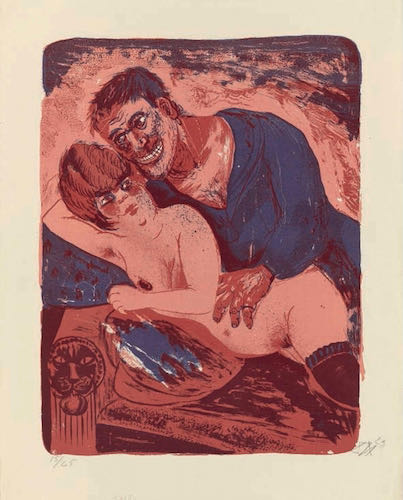.jpeg)
Otto Dix, a masterpiece collection for sale at Sotheby’s this week
ArtWizard 15.03.2021
“I had the feeling that there was a dimension of reality that had not been dealt with in art: the dimension of ugliness.”
Otto Dix
The war inspired artworks of Otto Dix become more and more interesting in the present times of social tension, political unrest and pandemic closures. The brutal truth of the works of Otto Dix, the grotesque images that can leave no viewer indifferent of the horrors of war, turn these works into a permanent alarm call. And it is no wonder that Sotheby decided to sell significant part of his works from “Der Krieg“ /The War to a new auction starting the 19th of March.
.jpeg)
Otto Dix, Suicide (The Hanged Man), 1922
Maybe not exactly comparable to the pandemic, but what is depicted by Dix is how life’s pleasures suddenly beckoned. For all men and women who had come back from the war scenes and front-line soldiers who had escaped the living hell of the battlefield, the end of the war meant that, after surviving, against all odds, it was time to make up for the ordeals and deprivations of the past years. Despite the economic challenges of the post war times, the thirst for entertainment was increasing.
The artist was himself a survivor of the brutality of the war and later depicted images of social satire, developing a grotesque, exaggerated aesthetic associated with the “Neue Sachlichkeit” /New Objectivity movement, whose artists sought to unsentimentally portray the social and political realities of the Weimar Republic. Expressionism was a dominant style in Germany in the years immediately after the World War I, where it suited the post-war atmosphere of cynicism, alienation, and disillusionment. War veterans and gaudily dressed ladies of the night were among the most depicted subjects by Otto Dix.

Otto Dix, Sailor and Girl, 1923
In one of his paintings – “Lens wird mit Bomben belegt” /Lens is bombed, 1924, the faces are terrified and disfigured. In another painting – the “Shädel” /The Skull, Otto Dix shows the full face of the war as in symbolizing what has been the devastating effect of the war to the humans – an empty Skull with worms getting out of it almost like flowers of the Evil.
.jpeg)
.jpeg)
Otto Dix, Lens is Bombed, 1924 / Otto Dix, Skull, 1924
Another part of his paintings is the grotesque depiction of the relations between soldiers and women of the night claiming that in these paintings exactly he sees all the ugliness of the human nature and how low a human being can go.
.jpeg)
.jpeg)
Otto Dix, Recumbent Nude (Woman sitting with Cigarette), 1923 / Otto Dix, Visit to Madame Germaine in Méricourt, 1924
Such devastating tolls of the war on the human nature can be seen in his paintings “Besuch bei Madame Germaine in Méricourt” /Visit to Madame Germaine’s in Méricourt, 1924 and “Lustmord” /Sex Murder, 1922.
.jpeg)
Otto Dix, Sex Murder, 1922
In “Die Skatspieler” /Skat Players, he depicts three World War I veterans with grossly distorted features, emphasizing their war-damaged bodies by foregrounding their amputated and prosthetic limbs and their deformed faces, framed by newspapers and playing cards. These disfigured veterans appear as composites of human flesh and artificial body parts, showing the devastating toll of war.
.jpeg)
Otto Dix, Skat Players, 1920
The portrait paintings of the artist depicted the Weimar society displaying a very distinctive, harsh style and the brutality of war. Dix joined the German Army in WW1 and was based in Dresden, and took part in the Battle of the Somme. After the war he began to paint again and was a member of the Berlin Secession group. His work was extremely critical of contemporary German society and by the time of WW2 his work was considered degenerative art by the Nazis. He was sacked as head teacher at the Dresden Art Academy and many of his paintings were destroyed.
.jpeg)
.jpeg)
Otto Dix, J.B.Neumann, 1922 / Otto Dix, Lady with Feathered Hat, 1923
.jpeg)
.jpeg)
Otto Dix, Procuress, 1923 / Otto Dix, Leonie,1923
During later life, Otto Dix’s paintings were recognized by both East and West Germany as highly significant depictions of a crucial period of history in 20th century Germany. Art collectors are reminded of it by the opportunity to buy such a painting as part of the upcoming sale at the Sotheby’s.
